
Barbour County is a county in the southeastern part of the U.S. state of Alabama. As of the 2020 census, the population was 25,223. Its county seat is Clayton. Its largest city is Eufaula. Its name is in honor of James Barbour, who served as Governor of Virginia.

Clayton is a town in and the county seat of Barbour County, Alabama, United States. The population was 3,008 at the 2010 census, up from 1,475 in 2000.

Eufaula is the largest city in Barbour County, Alabama, United States. As of the 2010 census the city's population was 13,137.
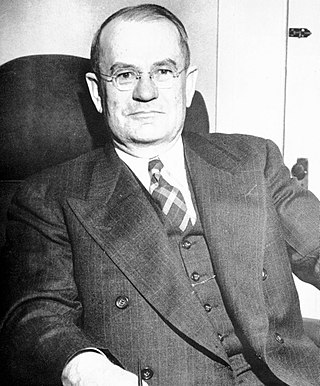
George Chauncey Sparks, known as Chauncey Sparks, was an attorney and Democratic American politician who served as the 41st Governor of Alabama from 1943 to 1947. He improved the state education of whites and expanded the state schools and centers for agriculture. He campaigned for passage of the Boswell Amendment to the state constitution, which was designed to keep blacks disfranchised following the US Supreme Court ruling Smith v. Allwright (1944) against the use of white primaries by the Democratic Party in the states.

William Lowndes Yancey was a political leader in the Antebellum South. As an influential "Fire-Eater", he defended slavery and urged southerners to secede from the Union in response to Northern antislavery agitation.

Robert Barnwell Rhett was an American politician who served as a deputy from South Carolina to the Provisional Confederate States Congress from 1861 to 1862, a member of the US House of Representatives from South Carolina from 1837 to 1849, and US Senator from South Carolina from 1850 to 1852. As a staunch supporter of slavery and an early advocate of secession, he was a "Fire-Eater", nicknamed the "father of secession".

Henry De Lamar Clayton Jr. was a United States representative from Alabama and a United States district judge of the United States District Court for the Middle District of Alabama and the United States District Court for the Northern District of Alabama.

Glenville is an unincorporated community in Russell County, Alabama, United States which used to be in Barbour County. During the Civil War, Company "H" of the 15th Regiment Alabama Infantry was raised from Barbour and Dale counties and called the "Glenville Guards". The Glennville Historic District, containing the antebellum core of the community, is a historic district listed on the National Register of Historic Places in 1979.
The Seth Lore and Irwinton Historic District is a historic district in Eufaula, Barbour County, Alabama. It was listed on the National Register of Historic Places in 1986 as Lore Historic District; the registration document identified and described 72 specific buildings. And then its boundaries were increased and the district was renamed to "Seth Lore and Irwinton Historic District" in 19__; the entire area then contained 738 contributing buildings.

Gaineswood is a plantation house in Demopolis, Alabama, United States. It is the grandest plantation house ever built in Marengo County and is one of the most significant remaining examples of Greek Revival architecture in Alabama.
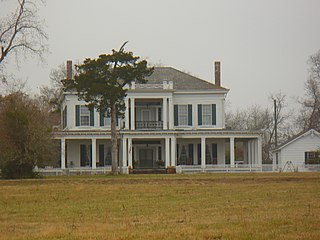
Cedar Grove Plantation, also known as the Charles Walker House, is a Greek Revival plantation house located near Faunsdale, Marengo County, Alabama. It is notable in having been the residence of Nicola Marschall for a brief period while the Walker family owned the property. The house was added to the National Register of Historic Places on 13 July 1993 as a part of the Plantation Houses of the Alabama Canebrake and Their Associated Outbuildings Multiple Property Submission.
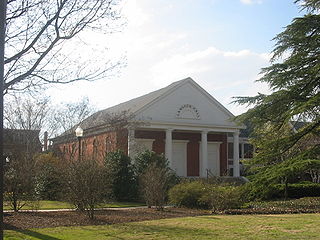
Langdon Hall is a building on the campus of Auburn University in Auburn, Alabama, United States. Built in the Greek Revival style in 1846 as the chapel for the Auburn Female College and moved to the Auburn University campus in 1883, Langdon Hall is the oldest building in the city of Auburn, and today houses an auditorium and office space for Auburn University staff. Before the Civil War, Langdon Hall served as the location for a series of debates on the question of Southern secession, involving William Lowndes Yancey, Alexander Stephens, Benjamin Harvey Hill, and Robert Toombs. Langdon Hall is named for Charles Carter Langdon, a former mayor of Mobile, Alabama, Alabama Secretary of State, and a trustee of Auburn University from 1872–1889.

Westwood is a historic plantation in Uniontown, Alabama, United States. The main house was built between 1836 and 1850 by James Lewis Price. It is in the Greek Revival style with some Italianate influence. The outbuildings include a smokehouse with architectural detailing identical to the main house, a carriage house, a dairy, and a cook's quarters. Westwood Plantation was added to the National Register of Historic Places as a historic district on November 21, 1974. Boundary increases were made to the district on March 15, 1984, and December 10, 1984.

Rosemount is a historic plantation house near Forkland, Alabama. The Greek Revival style house was built in stages between 1832 and the 1850s by the Glover family. The house has been called the "Grand Mansion of Alabama." The property was added to the National Register of Historic Places on May 27, 1971. The Glover family enslaved over 300 people from 1830 until 1860.

Fendall Hall, also known as the Young–Dent Home, is an Italianate-style historic house museum in Eufaula, Alabama. The two-story wood-frame structure, with a symmetrical villa-type floor-plan and crowning cupola, was built between 1856 and 1860 by Edward Brown Young and his wife, Ann Fendall Beall. It remained in the Young family for five generations, passing to the builders’ daughter, Anna Beall Young, and her husband, Stouten Hubert Dent in 1879. It was added to the National Register of Historic Places on July 28, 1970. The Alabama Historical Commission acquired it in 1973 and restored it to an appearance appropriate to a time-frame spanning 1880–1916.
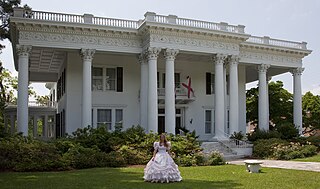
The Shorter Mansion is a Classical Revival-style historic house museum in Eufaula, Alabama. The two-story masonry structure was built in 1884 by Eli Sims Shorter II and his wife, Wileyna Lamar Shorter, but it burned in 1900. The house as seen today was built in 1906 and was designed by architect Curran R. Ellis of Macon, Georgia. Eli Sims Shorter died in 1908, but his wife resided in the house until 1927, when it was passed to their daughter, Fannie Shorter Upshaw. It was in turn inherited by Upshaw's daughter, Wileyna S. Kennedy, in 1959.
Spring Hill is an unincorporated community in Barbour County, Alabama, United States. Spring Hill is located at the junction of County Routes 49 and 89, 17.2 miles (27.7 km) northwest of Eufaula.

The Davidson–Smitherman House, also known as the Davidson Plantation, is a historic plantation house in Centreville in Bibb County, Alabama. It was added to the National Register of Historic Places on January 6, 1988.

The Phelps–Jones House is a historic residence in Huntsville, Alabama. One of the oldest buildings in Alabama, it was built in 1818, shortly after the initial federal land sale in Madison County in 1809. Despite having many owners, the original character of the house has remained. The two-story house is built of brick laid in Flemish bond, and has Federal and Georgian details. The original block has a bedroom and parlor separated by a central hall, with a dining room in an ell to the northeast. Staircases in the hall and dining room led to three bedrooms on the second floor. In 1956, a porch in the crook of the ell was enclosed, adding a bathroom and small bedroom. Another porch off the rear of the dining room was enclosed and converted into a kitchen. Interior woodwork, including six mantels, is in provincial Federal style. The façade is five bays wide, with twelve-over-twelve sash windows on the ground floor and twelve-over-eight on the second. A narrow hipped roof porch covers the double front door; originally a wider porch covered a single door flanked by narrow sidelights and topped with a transom. The house was listed on the Alabama Register of Landmarks and Heritage in 1979 and the National Register of Historic Places in 1982.
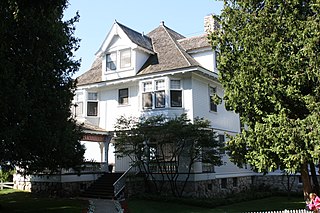
The Michigan Governor's Summer Residence, also known as the Lawrence A. Young Cottage, is a house located at the junction of Fort Hill and Huron roads on Mackinac Island, Michigan. It was listed on the National Register of Historic Places in 1997.




















